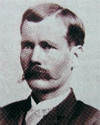Glenn Reynolds (sheriff) facts for kids
Quick facts for kids
Glenn Reynolds
|
|
|---|---|
 |
|
| Born | 1853 Texas, US |
| Died | November 2, 1889 Globe, Arizona, US |
| Allegiance | |
| Rank | Sheriff |
| Battles/wars | Comanche Wars American Civil War |
Glenn Reynolds (born 1853 – died November 2, 1889) was an American sheriff, cowboy, and militiaman from the Old West. He is remembered for his death during the Kelvin Grade Massacre in Arizona Territory. This happened when a group of Apache people escaped from his care.
Contents
Life and Times of Glenn Reynolds
Early Life and War Service
Glenn Reynolds was born in 1853, probably near Albany, Texas. When he was young, he served during the American Civil War. His job was to protect frontier settlements from raids by the Comanche people. This happened while older soldiers were fighting the Union Army.
From Cowboy to Sheriff
After the Comanche Wars, Reynolds worked as a cowboy. He helped drive cattle from Texas all the way to Kansas. In 1885, he was elected sheriff of Throckmorton County. His family was well-known and owned a cattle company, which helped him get elected.
Around 1887, Reynolds and his family moved across the Southwest. They brought 3,000 cattle and 200 horses to Bowie Station in Arizona Territory. He then settled on a ranch in Pleasant Valley. This area was known for conflicts between settlers, called the Tonto Basin War. During this time, Reynolds was connected to an event where a man named Al Rose was killed. Rose was shot by several masked men. Because of the difficult situation in Pleasant Valley, Reynolds moved his family to Globe. There, he was elected sheriff in November 1888.
The Journey with Prisoners
In 1889, Sheriff Reynolds was ordered to transport a group of prisoners from Globe to Yuma Territorial Prison. Among the prisoners were the Apache Kid, Pas-Lau-Tau, and others involved in a past event at San Carlos. There was also a horse thief from Mexico named Jesus Avott.
The first part of the trip was by stagecoach to Casa Grande. From there, the prisoners would take a train to Yuma. Reynolds was in charge of the group. He was joined by Sheriff William A. Holmes and the coach driver, Eugene Middleton.
On November 1, 1889, they left Globe for Casa Grande. They stopped for the night at Kelvin, Arizona, near the Gila River. They set out early the next morning.
The Escape at Kelvin Grade
There was a very steep part of the road called Kelvin Grade. Reynolds decided that the horses might not be able to pull the heavy coach with all the prisoners up the hill. So, he planned for most of the prisoners to get out and walk up the grade. All the prisoners were handcuffed together, except for Avott. The Apache Kid and one other man were considered too dangerous, so they stayed inside the coach.
When they reached Kelvin Grade, the lawmen followed the plan. Reynolds told Middleton to drive the coach ahead and watch the Apache Kid. Reynolds and Holmes stayed with the other prisoners who were walking.
At a sharp turn in the trail, the Apache prisoners tried to escape. Two of the chained men attacked Reynolds, and two others attacked Holmes. During the struggle, Pas-Lau-Tau grabbed a rifle from one of the guards and shot Reynolds, killing him. Holmes also died during the struggle from a heart attack. Middleton, who was trying to stop the Apache Kid from escaping, was shot but survived. Avott hid in a bush. After the Apache men ran off, Avott alerted the authorities and was later pardoned for his help. Middleton was able to walk back to Kelvin for help.
Aftermath of the Escape
The Apache men took items from Reynolds and the others before leaving. The Apache Kid even stopped another man from hurting Middleton more seriously. Reynolds was wearing a coat and gloves because it was cold. His coat made it hard for him to reach his pistol. His gloves prevented the Apache men from stealing his gold ring. The ring was later given to Reynolds' wife when he was buried in Globe, next to his son who had died earlier.
After these events, the United States Army began a search to catch the escaped prisoners. By October 1890, all of them were caught except for the Apache Kid. That same year, Mexican police found and killed an old Apache man in northern Mexico. Reynolds' pistol and watch were found on this man and later returned to his family.
Images for kids



